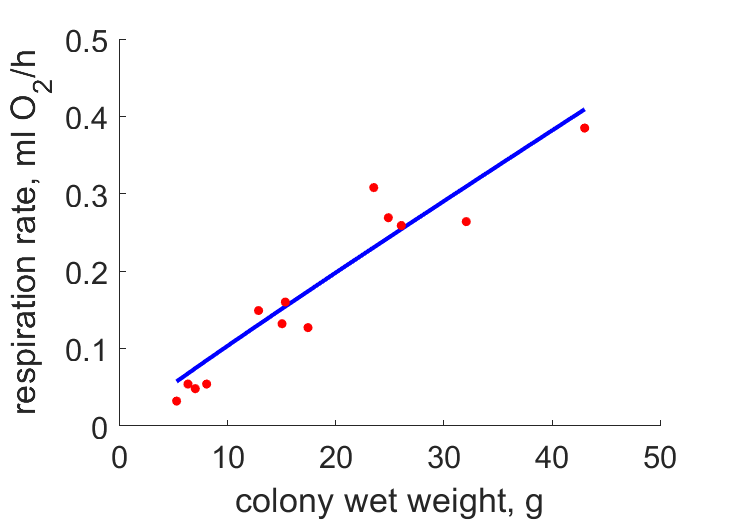Predictions & Data for this entry
| Model: std | climate: MB, MC | migrate: Mo | phylum: |
| COMPLETE = 2.0 | ecozone: MC | food: biP | class: |
| MRE = 0.106 | habitat: 0jMp, jiMb | gender: Hh | order: |
| SMSE = 0.028 | embryo: Mv | reprod: Aa | family: |
Zero-variate data
| Data | Observed | Predicted | (RE) | Unit | Description | Reference |
|---|---|---|---|---|---|---|
| ab | 1.7 | 1.576 | (0.07311) | d | age at birth | guess |
| tp | 90 | 94.52 | (0.05024) | d | time since birth at puberty | guess |
| am | 40 | 40 | (4.175e-05) | d | life span | guess |
| Lp | 4 | 3.798 | (0.05044) | cm | colony length at puberty | Soes1981 |
| Li | 50 | 55.64 | (0.1127) | cm | ultimate colony length | MillSant2019 |
| Wwb | 1.4e-05 | 1.401e-05 | (0.0009061) | g | wet weight at birth | MillSant2019 |
| Ri | 4.11e+04 | 4.701e+04 | (0.1439) | #/d | maximum reprod rate | guess |
Uni- and bivariate data
| Data | Figure | Independent variable | Dependent variable | (RE) | Reference |
|---|---|---|---|---|---|
| LWw |   | length of colony | wet weight | (0.2071) | MillSant2019 |
| LWw1 |   | length of colony | wet weight | (0.2657) | HensPakh2019 |
| WJO |  | colony wet weight | respiration rate | (0.1623) | HensPakh2019 |
Pseudo-data at Tref = 20°C
| Data | Generalised animal | Pyrosoma atlanticum | Unit | Description |
|---|---|---|---|---|
| v | 0.02 | 0.02377 | cm/d | energy conductance |
| p_M | 18 | 30.71 | J/d.cm^3 | vol-spec som maint |
| k_J | 0.002 | 0.002 | 1/d | maturity maint rate coefficient |
| k | 0.3 | 0.1357 | - | maintenance ratio |
| kap | 0.8 | 0.9 | - | allocation fraction to soma |
| kap_G | 0.8 | 0.8029 | - | growth efficiency |
| kap_R | 0.95 | 0.475 | - | reproduction efficiency |
Discussion
- Data refers to colony; length of colony relates to weight almost as a V1-morph, but zooids are probably isomorphic
Facts
- Pelagic colonial tunicate, which can reproduce asexually, also as colony (Ref: oceana)
- P. atlanticum exhibits dielvertical migration to a maximum depth of 800–1000 m (Ref: HensPakh2019)
- Hermaphroditic; external fertilisation (Ref: Wiki)
- Clearance rate in L/h: 0.0558 * (colony length in mm)^1.174 (Ref: HensPakh2019)
- Strongly bioluminescent in flashes (Ref: Bone1998)
Bibliography